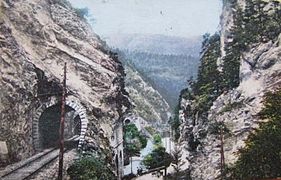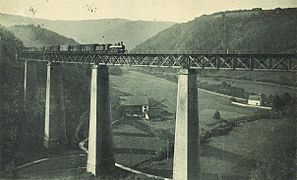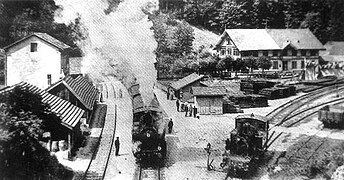| Jura–Bern–Lucerne in 1889 | |||||||||||||||||||||||||||||||||||||||||||||||||||||||||||||||||||||||||||||||||||||||||||||||||||||||||||||||||||||||||||||||||||||||||||||||||||||||||||||||||||||||||||||
|---|---|---|---|---|---|---|---|---|---|---|---|---|---|---|---|---|---|---|---|---|---|---|---|---|---|---|---|---|---|---|---|---|---|---|---|---|---|---|---|---|---|---|---|---|---|---|---|---|---|---|---|---|---|---|---|---|---|---|---|---|---|---|---|---|---|---|---|---|---|---|---|---|---|---|---|---|---|---|---|---|---|---|---|---|---|---|---|---|---|---|---|---|---|---|---|---|---|---|---|---|---|---|---|---|---|---|---|---|---|---|---|---|---|---|---|---|---|---|---|---|---|---|---|---|---|---|---|---|---|---|---|---|---|---|---|---|---|---|---|---|---|---|---|---|---|---|---|---|---|---|---|---|---|---|---|---|---|---|---|---|---|---|---|---|---|---|---|---|---|---|---|---|---|
| History | |||||||||||||||||||||||||||||||||||||||||||||||||||||||||||||||||||||||||||||||||||||||||||||||||||||||||||||||||||||||||||||||||||||||||||||||||||||||||||||||||||||||||||||
| Opened | 1874 | ||||||||||||||||||||||||||||||||||||||||||||||||||||||||||||||||||||||||||||||||||||||||||||||||||||||||||||||||||||||||||||||||||||||||||||||||||||||||||||||||||||||||||||
| Closed | 1890 | ||||||||||||||||||||||||||||||||||||||||||||||||||||||||||||||||||||||||||||||||||||||||||||||||||||||||||||||||||||||||||||||||||||||||||||||||||||||||||||||||||||||||||||
| |||||||||||||||||||||||||||||||||||||||||||||||||||||||||||||||||||||||||||||||||||||||||||||||||||||||||||||||||||||||||||||||||||||||||||||||||||||||||||||||||||||||||||||
The Bernese Jura Railway (Chemins de fer du Jura bernois, abbreviated Jura bernois, JB) was a railway company in Switzerland. The company was called the Jura–Bern–Luzern (Jura–Bern–Lucerne, JBL) from 1 July 1884. The Jura–Bern–Lucerne merged with the Western Switzerland–Simplon Railways (Suisse-Occidentale–Simplon, SOS) to form the Jura–Simplon Railway (Jura-Simplon-Bahn), JS) on 1 January 1890.
History

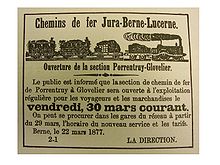
The railway network of the Canton of Bern initially developed according to the interests of the Swiss Central Railway (Schweizerische Centralbahn, SCB). The Grand Council of Bern, decided to conclude a contract with the SCB in 1852. The Central Railway undertook to build the Murgenthal–Bern line and the Solothurn–Herzogenbuchsee railway within four years and in return received tax exemption and the privilege of being given preferential treatment in future grants of concessions to build railways. The Central Railway's construction now concentrated for a period on the more populated areas in the Swiss Plateau. The rugged and economically less developed Jura had a much more limited railway network. The Central Railway had no interest in competing with its existing Hauenstein Railway.
Under the chairmanship of Xavier Stockmar, the Zentralkomitee für die jurassische Eisenbahn (Central Committee for the Jura Railways) planned a railway line from Biel/Bienne to Basel with a branch from Delémont to Porrentruy. Although the concession was granted, it was not built due to lack of funds. To connect the Bernese Jura to the old part of the canton, the Grand Council provided a subsidy of CHF 6,950,000 of the estimated construction cost of CHF 40 million in 1867. The Delémont–Delle railway, which was financed by French companies, was built and handed over for operations on 23 September 1872.
Capital procurement, construction and transfer of track


A new situation arose in 1871, with the cession of Alsace-Lorraine to Germany after the Franco-Prussian War. A line built across French territory and through the Bernese Jura would connect the Paris–Belfort line directly to the Swiss Plateau. The Jura bernois was founded in 1874 as a joint-stock company, with the French Chemins de fer de l'Est subscribing CHF 4½ million and the canton of Basel-Stadt subscribing CHF 0.5 million. The municipalities and Bürgergemeinden of the Jura purchased a total of over 7 million shares, partially exploiting their forests to fund them.
The Jura bernois began construction and opened individual sections of its network between Biel, Convers (near La Chaux-de-Fonds), Delle and Basel between 1872 and 30 March 1877. It complemented its network through acquisitions. The JB bought the bankrupt Jura industriel (JI) for CHF 3.6 million on 1 May 1875 and the Chemin de fer Porrentruy–Delle (PD) for CHF 1.99 million on 16 August 1876. It took over the Bernese State Railway (Bernische Staatsbahn, BSB), including the Zollikofen–Biel –La Neuveville line in 1877. The canton of Bern received JB shares worth CHF 11.56 million in return.
The JB was built during the railway construction boom after 1872 and interest rates and construction prices rose sharply. The recession of 1876 and the subsequent "railway crisis" almost bankrupted even the financially solid Swiss Northeastern Railway (Schweizerische Nordostbahn, NOB). Against this background, the consistent profits of the JB were unusual. The revenue from freight was higher than the revenue from passengers in each year from 1878.
Jura–Bern–Lucerne
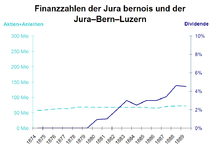
The positive operating results allowed the Jura–Bern–Luzern, to pay a dividend every year.



For the start of the operations of the Bern-Lucerne Railway Company (Bern-Luzern-Bahn, BLB) in 1875, the BLB and the Bernese Jura formed a joint operating company called the Jura–Bern–Luzern (Lucerne). This company continued to exist even after the bankruptcy of the BLB and, as of 1 July 1882, the JB leased the line from Bern to Lucerne, which now belonged to the canton of Bern. Thus, the Bernese Jura came into possession of the continuous Delle–Bern–Lucerne line, which connected with the Gotthard Railway. This route competed with the route of the Swiss Central Railway (Centralbahn) via Olten, which lost direct access to the railway from Basel to France after the Franco-Prussian War. The extended route network prompted the railway to change its name to the Jura–Bern–Luzern (JBL).
Ten years after its construction, the Canton of Neuchâtel exercised its buyback right and acquired the Neuchâtel–La Chaux-de-Fonds–Le Locle line on 1 January 1886 for around CHF 5 million, so it could lease it to the newly established Jura neuchâtelois (JN). However, the JN could not earn enough to pay its rent, which made support by the public sector necessary.
The Jura–Bern–Luzern built the Brünig Railway from 25 August 1886. With the opening of the first, over 44 km long section from Alpnachstad via the Brünig Pass to Brienz on 14 June 1888, the network of the JBL was significantly extended. The extension from Alpnachstad to Lucerne followed on 1 June 1889. The metre-gauge line with sections of rack connects the two tourist regions of Central Switzerland and the Bernese Highlands. In addition, it was considered to have great military importance.
The Jura–Bern–Luzern also took care of the operation of the Bödelibahn (Bödeli Railway, BB) Därligen–Interlaken–Bönigen opened in 1872.
Merger into the Jura–Simplon Railway
On 1 January 1890, the Jura–Bern–Luzern including the Gümligen–Lucerne line, which was owned by the canton of Bern, and the Western Swiss Railways (Suisse-Occidentale–Simplon, SOS) merged to form the Jura–Simplon Railways (Chemins de fer du Jura-Simplon, JS). From this point on it was the largest Swiss railway company; it was partly owned by the Swiss Confederation as a result of the purchase of shares on the market. On 1 January 1891, the JS took over the operations of the Pont–Vallorbe Railway (Chemin de fer Pont–Vallorbe, PV). Only the JS had sufficient resources to progress on the construction of the Simplon Tunnel that had been planned for decades.
The bridge over the Birs built by Gustave Eiffel for the Bernese Jura collapsed shortly after the merger. The Münchenstein rail disaster on 14 June 1891 was the largest railway disaster in Switzerland to that time.
Graphical summary
Bwlow is an overview of the history of the Jura bernois and the Jura–Bern–Luzern (O: opening; T: takeover):
| Jura industriel (JI) O: 2.7.1857 T: 1.5.1875 | |||||||||||||||||||||||||||||||||||||
| East–West Railway (OWB) O: 3.12.1860 T: 1.6.1861 | |||||||||||||||||||||||||||||||||||||
| Bernese State Railway (BSB) T: 24.5.1877 | |||||||||||||||||||||||||||||||||||||
| Porrentruy–Delle (PD) O: 23.9.1872 T: 16.8.1876 | |||||||||||||||||||||||||||||||||||||
| Bernese Jura Railway T: 30.4.1874 | |||||||||||||||||||||||||||||||||||||
| Gümligen–Langnau T: 1.8.1875 | Bern-Lucerne Railway (BLB) T: 15.1.1877 | ||||||||||||||||||||||||||||||||||||
| Canton of Bern T (lease): 1.7.1882 | |||||||||||||||||||||||||||||||||||||
| from 1.7.1884 Jura–Bern–Lucerne T: 1.1.1890 | |||||||||||||||||||||||||||||||||||||
| Jura neuchâtelois (JN) | Neuchâtel–Le Locle T: 1.1.1886 | ||||||||||||||||||||||||||||||||||||
| Western Switzerland– Simplon (SOS) T: 1.1.1890 | Pont–Vallorbe (PV) O: 31.10.1886 T: 1.1.1891 | ||||||||||||||||||||||||||||||||||||
| Jura–Simplon Railways (JS) | |||||||||||||||||||||||||||||||||||||
Route network
| No. | Route | Section | Opening | Remarks | Length |
|---|---|---|---|---|---|
| 1. | Bern–Biel –Sonceboz–Moutier–Delémont–Basel | Bern–Bern Wylerfeld | (15 November 1858) | Section of the Olten–Bern railway used jointly with the SCB | (7.46 km) |
| Bern Wylerfeld–Zollikofen | (16 June 1857) | ||||
| Zollikofen–Lyss–Biel/Bienne | (1 June 1864) | Lyss–Busswil section taken over from the BSB on 24 May 1875; 2 tracks since 1877 |
115.54 km | ||
| Biel–Sonceboz–Tavannes | 30 April 1874 | ||||
| Tavannes–Court | 16 December 1876 | ||||
| Court–Moutier | 24 May 1877 | ||||
| Moutier–Delémont | 16 December 1876 | Trains reverse in Delémont station | |||
| Delsberg–Basel Centralbahnhof | 25 September 1875 | ||||
| 2. | Sonceboz–La Chaux-de-Fonds | Sonceboz–Le Creux–Convers | 30 April 1874 | Connection to Neuchâtel–Le Locle-Col-des-Roches railway. Le Creux–Convers operations ended on 17 December 1888 and the line closed on 1 July 1895 | 29.55 km |
| Le Creux–La Chaux-de-Fonds | 17 December 1888 | Own access to La Chaux-de-Fonds after separation from the JN on 1 January 1886 | |||
| 3. | Delsberg–Delle | Delsberg–Glovelier | 15 October 1876 | 39.84 km | |
| Glovelier–Porrentruy | 30 March 1877 | ||||
| Porrentruy–border (–Delle) | (23 September 1872) | Taken over by the PD on 16 August 1876 | |||
| 4. | Bern–Lucerne | Bern Wylerfeld–Gümligen | (1 July 1859) | Joint use of this section of the Bern–Thun railway with the SCB | (5.38 km) |
| Gümligen–Langnau | (1 June 1864) | Originally BLB, bought by the canton of Bern at auction on 15 January 1877 and managed by the JB leased from the canton of Bern since 1 July 1882 |
3.27 km | ||
| Langnau–Fluhmühle | (11 August 1875) | ||||
| Fluhmühle–Lucerne | (1 June 1859) | Joint use of this section of the Olten–Lucerne railway with the SCB | (3.27 km) | ||
| 5. | Biel–Neuchâtel (BE-NE canton border) | (3 December 1860) | Connecting in Lausanne to OS network, taken over by the BSB on 24 May 1875 |
14.45 km | |
| 6. | Neuchâtel–La Chaux-de-Fonds–Le Locle–Col des Roches | Neuchâtel–Neuchâtel-Vauseyon | (7 November 1859) | Joint use of the section of the La Neuveville–Lausanne line with FS | (1.37 km) |
| Neuchâtel-Vauseyon–Les Hauts-Geneveys | (1 December 1859) | Taken over by the JI on 1 May 1875, transferred to the JN on 1 January 1886 |
(38.21 km) | ||
| Les Hauts-Geneveys–Convers | (15 July 1860) | ||||
| Convers–La Chaux-de-Fonds | (27 November 1859) | ||||
| La Chaux-de-Fonds–Le Locle | (2 July 1857) | ||||
| Le Locle–Col des Roches–border(–Besançon) | 4 August 1884 | ||||
| 7. | Brünig Railway | Lucerne–Alpnachstad | 1 June 1889 | 1,000 mm (3 ft 3+3⁄8 in) metre gauge, partly rack Trains reverse in Meiringen station |
57.64 km |
| Alpnachstad–Brienz | 14 June 1888 | ||||
| 8. | Lyss–Fräschels (BE-FR canton border) | 12 June 1876 | Connection in Murten to the SO network | 12.97 km | |
| Total | 269.49 km | ||||
Rolling stock
In 1882, the company owned 67 locomotives, 188 passenger cars and 682 freight cars.
The locomotives from the beginning were designated as class A for express-tank locomotives, B for locomotives of "Bourbonnais" design (referring to the Compagnie du chemin de fer de paris à Lyon par le Bourbonnais, a predecessor company of the PLM, which developed the design) for passenger trains on mountain lines and freight trains on valley routes, C for freight locomotives, D for pilot tender locomotives and E for shunters. The locomotives were designated according to the uniform system used throughout Switzerland from 1887.
The following locomotives were available to the Jura–Bern–Lucerne. The class designation valid from 1902 is listed in brackets.
| Class from 1873 |
Class from 1887 |
JBL no. | Name | JS no. from 1890 |
SBB no. from 1903 |
Manufacturer | Build year | Remarks | Scrapped | Image |
|---|---|---|---|---|---|---|---|---|---|---|
| I | A2 (Ec 2/4) | 1–12 | Property of the Bern-Lucerne Railway (see there) | |||||||
| A | A2 (Eb 2/4) | 13 | 13 | 5441 | SLM | 1876 | Biel workshop from 1903 | 1917 |  Passenger locomotive A2 no. 18 | |
| 14 | 14 | 5442 | 1904 | |||||||
| 15 | 15 | – | 1900 | |||||||
| 16 | 16 | – | 1900 | |||||||
| 17 | 17 | 5451 | Esslingen | 1880 | 1911 | |||||
| 18 | 18 | 5452 | 1927 | |||||||
| 19 | 19 | 5453 | 1933 | |||||||
| 20 | 20 | 5454 | 1925 | |||||||
| 21 | 21 | 5455 | 1881 | 1928 | ||||||
| 22 | 22 | 5456 | 1925 | |||||||
| 23 | 23 | 5457 | 1911 MO 1; sold in 1917 | |||||||
| 24 | 24 | 5458 | 1919 | |||||||
| 25 | 25 | 5459 | 1883 | Heating car Xd 99009 from 1927 | 1927 | |||||
| 26 | 26 | 5460 | 1919 | |||||||
| 27 | 27 | 5462 | SLM | 1888 | 1925 | |||||
| 28 | 28 | 5461 | Heating car Xd 99011 from 1927 | 1927 | ||||||
| 29 | 29 | 5463 | 1930 | |||||||
| 30 | 30 | 5464 | EB 9 from 1926 | 1933 | ||||||
| 31 | 31 | 5465 | 1919 | |||||||
| 32 | 32 | 5466 | Heating car Xd 99010 from 1927 | 1933 | ||||||
| AI | B2E (Ec 2/5) | 41–43 | Taken over from the Jura industriel in 1875 (see there) | Esslingen | 1856–1858 | No. 42 was taken over in 1886 by the JN | 1883–1888 | |||
| – | A3T (B 3/4) |
41' | 205 | 1561 | SLM | 1889 | 1924 | |||
| 42' | 206 | 1562 | 1924 | |||||||
| 43' | 207 | 1563 | 1924 | |||||||
| 44 | 208 | 1564 | 1929 | |||||||
| 45 | 209 | 1565 | 1924 | |||||||
| 46 | 210 | 1566 | 1924 | |||||||
| 47 | 211 | 1567 | 1924 | |||||||
| 48 | 212 | 1568 | 1932 | |||||||
| B | B3T (C 3/3) | 51–54 | Property of the Bern-Lucerne Railway (see there) |  Bourbonnais-hauling tender locomotive B3T no. 54 | ||||||
| 55 | Delémont | 425 | – | SACM | 1875 | 1900 | ||||
| 56 | Laufon | 426 | – | 1901 | ||||||
| 57 | Dornach | 427 | – | 1901 | ||||||
| 58 | Bâle | 428 | – | 1902 | ||||||
| 59 | Moutier | 429 | 2416 | 1876 | 1905 | |||||
| 60 | St-Ursanne | 430 | 2405 | 1903 | ||||||
| 61 | Porrentruy | 431 | 2415 | 1911 | ||||||
| C | C3T (D 3/3) | 101 | Stockmar | 541 | 3392 | SACM | 1874 | Originally had operating numbers 1–6. When the JB took over the operation of BLB in 1875, a new numbering scheme was established and the locomotives were renumbered. |
1904 |  JS no. 542, built in Mülhausen |
| 102 | Jura-Bernois | 542 | 3393 | 1904 | ||||||
| 103 | St-Imier | 543 | 3360 | 1908 | ||||||
| 104 | Bienne | 544 | 3361 | 1907 | ||||||
| 105 | Suze | 545 | – | SLM | 1874 | 1901 |  JB no. 6 of SLM | |||
| 106 | Birse | 546 | 3399 | 1913 | ||||||
| 107 | Aare | 547 | 3388 | SACM | 1875 | 1908 | ||||
| 108 | Thielle | 548 | 3394 | 1907 | ||||||
| 109 | Sorne | 549 | 3395 | 1905 | ||||||
| 110 | Doubs | 550 | – | 1902 | ||||||
| 111 | Allaine | 551 | 3362 | 1876 | 1917 | |||||
| 112 | Chasseral | 552 | 3396 | 1904 | ||||||
| 113 | Montoz | 553 | 3397 | 1906 | ||||||
| 114 | Mont-Terrible | 554 | 3398 | 1906 | ||||||
| 115 | Rangiers | 555 | 3363 | 1917 | ||||||
| CI | D3E (Ed 3/5) | 141, 142 and 144 | Taken over by the Jura industriel in 1875 (see there) | Workshop of the SCB | 1859 | Taken over by the JN in 1886 | 1898–1905 | |||
| 143, 145 | Esslingen | 1873 | 1912–1914 | |||||||
| D | C3 (Ed 3/3) | 151–157 | Property of the Bern-Lucerne Railway (see there) | |||||||
| E | F3 (E 3/3) | 201 | 851 | 8571 | SLM | 1875 | 1913 | |||
| 202 | 852 | 8572 | 1911 | |||||||
| Locomotives of the narrow gauge Brünig Railway: | ||||||||||
| – | G3 (G 3/3) | 301 | 901 | 101 | SLM | 1887 | 1911 | 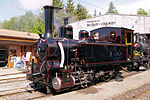 Brünig valley locomotive no. 309, now at the BC | ||
| 302 | 902 | 102 | 1912 | |||||||
| 303 | 903 | 103 | 1888 | 1911 | ||||||
| 304 | 904 | 104 | 1916 Trento–Malè 104 | |||||||
| 305 | 905 | 105 | 1916 Trient–Male 105 | |||||||
| 306 | 906 | 106 | 1889 | 1916 IMB 106 1919 Trient–Male 106 |
||||||
| – | HG2 (HG 2/2) | 351 | 951 | 1001 | SLM | 1887 | 1908 SV 10 1927 MCL 241 |
1936 |  Brünig mountain locomotive no. 352 for mixed adhesion and rack operations | |
| 352 | 952 | 1002 | 1888 | 1908 MCM 2 | ||||||
| 353 | 953 | 1003 | 1908 O&K | |||||||
| 354 | 954 | 1004 | 1908 | |||||||
| 355 | 955 | 1005 | 1908 | |||||||
| 356 | 956 | 1006 | 1889 | 1911 | ||||||
| 357 | 957 | 1007 | 1911 | |||||||
| 358 | 958 | 1008 | 1911 | |||||||

References
Notes
- ^ Now Basel SBB
- Junction with the Olten–Lucerne line of the Centralbahn
- According to bahndaten.ch the JBL was created by renaming the Jura bernois. The Bern–Lucerne line was not taken over by the JBL, but continued to be leased from the canton of Bern.
- Placid Weissenbach puts the purchase price at CHF 5,141,079, while an amount of CHF 5.25 million is mentioned in bahndaten.ch.
- Determined by chainage
- Trains reverse in Convers station
- Now Gütsch
- Trains reverse in Chambrelien station
- Property length according to official railway statistics quoted in bahndaten.ch
- The SBB renumbered the locomotives taken over after the completion of boiler revisions.
Footnotes
- Foreign Railways of the World. The Railways Register, St. Louis, USA. 1884. p. 260.
Sources
- Frey, Thomas; Schiedt, Hans-Ulrich. "Jura bernois". bahndaten.ch. Daten zu den Schweizer Eisenbahnen 1847–1920 (in German). ViaStoria. Retrieved 20 December 2018.
- Frey, Thomas; Schiedt, Hans-Ulrich. "Jura–Bern–Luzern". bahndaten.ch. Daten zu den Schweizer Eisenbahnen 1847–1920 (in German). ViaStoria. Retrieved 20 December 2018.
- Frey, Thomas; Schiedt, Hans-Ulrich. "Brünigbahn". bahndaten.ch. Daten zu den Schweizer Eisenbahnen 1847–1920 (in German). ViaStoria. Retrieved 20 December 2018.
- Junker, Beat. "Der Weg zur Staatskrise von 1877/78". Die Entstehung des demokratischen Volksstaates 1831–1880 (in German). Vol. 2. Historischer Verein des Kantons Bern.
{{cite book}}:|work=ignored (help) - Moser, Alfred (1967). Der Dampfbetrieb der Schweizerischen Eisenbahnen 1847–1966 (in German). Basel und Stuttgart: Birkhäuser Verlag.
- Wägli, Hans G. (2010). Schienennetz Schweiz und Bahnprofil Schweiz CH+ (in German). Zürich: AS Verlag. ISBN 978-3-909111-74-9.
- Weissenbach, Plazid (1913). Das Eisenbahnwesen der Schweiz (PDF) (in German). Vol. 1: Geschichte des Eisenbahnwesens. p. 66. Retrieved 20 December 2018.
- "Die Bern-Luzern-Bahn". Die Eisenbahn (in German). 6 (3): 21–22. 1877. Retrieved 20 December 2018.
